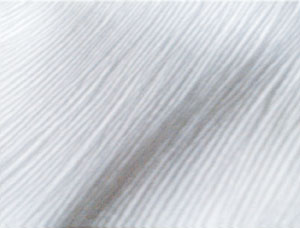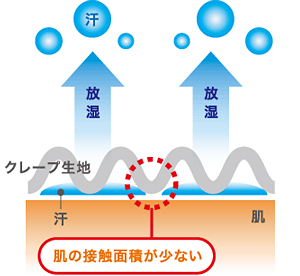Archives
綿ちぢみについて
綿ちぢみについて
日本特有のウエア「ステテコ」の代表的な素材は、綿ちぢみ(綿クレープ)と呼ばれ、江戸時代末期から続く歴史のある織物です。緯糸(よこいと)にだけ、強く撚りをかけた糸を用いて織り上げた後、さらし工程によって緯糸が戻ろうとする力を利用して布面にしぼ(波状、または粒状の凹凸)を出します。このしぼがあるため肌に密着せず、いつもサラッとした爽やかな肌ざわり。またその凹凸から天然のストレッチ性を持ちます。
特長としては、吸汗性(汗をよく吸う)、速乾性(吸った汗をすばやく乾かす)、通気性(新しい空気を入れ替える)、吸湿性、放湿性などがあげられ、綿ちぢみは蒸し暑い日本の夏に最適な素材だといえます。
以前は日本数カ所にあった綿ちぢみの産地もここ数年で減少し、現在では琵琶湖西岸に位置する、滋賀県高島地区が主な産地になってます。 ここで生産されたちぢみ生地は「高島ちぢみ」と呼ばれ200年もの歴史があり、今も高い人気を誇っています。
About cotton chijimi
The unique Japanese pants, steteco, are typically made of a traditional textile called cotton chijimi (cotton crape) handed down from the end of Edo Period. The textile is woven using wefts formed into a powerful ply, and its uneven (wavy or granular) surface called shibo is produced through the bleaching process utilizing the untwisting force of wefts. The irregular pattern of shibo provides the textile with a constantly dry, fresh touch and stretchability.
Cotton chijimi absorbs sweat efficiently and rapidly dries the absorbed sweat, is breathable and has moisture absorption and diffusion properties, making it the optimal material for surviving the hot and humid summer in Japan.
Several regions in Japan used to produce cotton chijimi, but the number has decreased in the recent years, making Takashima, located on the west coast of Lake Biwa in Shiga, the current main producing region. Chijimi textiles produced in this region with over 200 years of history, called Takashima chijimi, enjoy great popularity.

